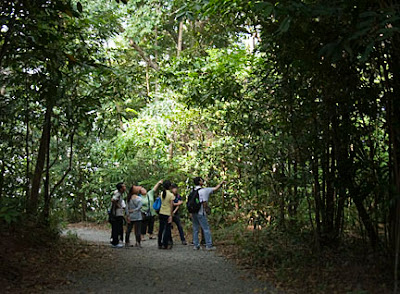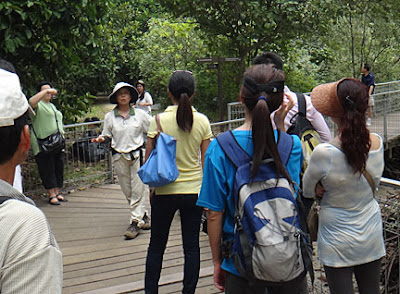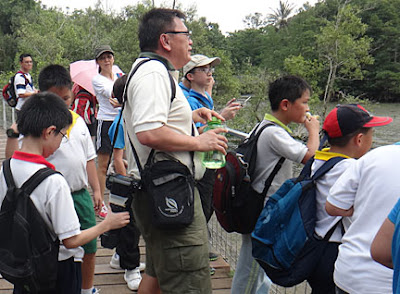How nice to be greeted by Young mama pig and her piglets when we arrive at Chek Jawa! They've grown so much since I last saw them in March. Grandma pig even showed up too.
The Naked Hermit Crabs are glad to be able to share Chek Jawa with some special friends of NParks.
Here we are leaving Changi. Along the way, Ivan shared about the terns that nest at Squance Rock on Changi and we had a look at the tall Pulai tree that sticks out of the canopy.
As we start our walk, the wild boar are foraging in the forest nearby. In Chek Jawa, thousands of people have peaceful interactions with wild boar. If we don't feed the wild animals, they will not bother people. Wild animals that associate people with food handouts will beg and harass people, leading to complaints. Such complaints often means the wild animals pay with their lives.
We stop by the hornbill nest box. The Oriental pied hornbill nest in a suitable hole in a tall tree. The breeding pair seals the female inside the hole. A narrow slit is left open so the male can feed her and the chicks. This remarkable behaviour is believed to deter large predators. The population of hornbills are limited by the number of suitable natural tree holes. The Singapore Hornbill Project to provide nesting boxes has had much success in raising the population of our Oriental pied-hornbills.
The coastal forest that edge Chek Jawa is full of all kinds of interesting plants. Many are rare in Singapore because most of our natural cliffs have been developed. Among the special plants is the Endangered Delek air which has pretty fragrant blue flowers.
Today the tide is lowish so the water is quite clear. In the incoming tide many hungry animals rush in. These animals had to leave the intertidal for deeper water during low tide. We spot Needlefishes and see a very large school of fish!
Ivan and Ley Kun point out the many shorebirds that feed on the seagrass meadows and shallow waters in the Chek Jawa lagoon. Here we see the large Great billed heron, medium sized Grey heron, smaller Egret. And nearby (not in photo) is the much smaller Green heron! When we visit Chek Jawa during the northern winter, we can see many more kinds of migratory shorebirds.
Good thing Ley Kun pushed us to hurry out to the seagrass meadows so we can spot some animals before the tide rushed in. We spotted several Carpet anemones nestled among Ribbon seagrass. As well as a Purple branching sponge drapped in Sea lettuce seaweed which was 'blooming' on the shore today. And a horseshore crab too!
Among the interesting sightings is this special Sundial snail that Chay Hoon first spotted on Chek Jawa, and later on our Southern shores. The rocky shore and boardwalk legs also had large oysters and other encrusting animals.
I have no idea what this crab is. There were several of them on the mudflats and I don't remember seeing them in the past.
The Blue-spotted mudskipper is my favourite! It has beautiful blue spots and a large flag-like dorsal fin. There were several large ones near the boardwalk. We also saw 'dancing mudskippers' that can stand on their tails to impress the lady mudskippers. But today, although we saw many of these mudskippers, none of them were 'dancing'.
In the distance, we see a group of students cleaning up the shore. In the middle of the seagrass meadows is Valerie and her helper, working on her seagrass project.
Along the way, we met up with Yook Sau of Ubin NParks who explained that the kids were doing lots of work at Ubin as part of Service Learning. They cleaned up the shore, they cleared up invasive plants and other good works. Wow, they sure have a lot of energy.
Here are the enthusiastic students led by Alan of Ubin NParks who was showing them the amazing fiddler crabs that teem on the shore beneath the boardwalk.
Some of the students are more interested in Alan's camera.
They seem quite impressed by his camera!
Soon we were in the back mangroves where there are all kinds of fascinating animals. The Mud lobster is a keystone species here, creating the mud mounds that become a 'condo' for all kinds of animals, complete with swimming pool for smaller creatures to shelter in during low tide.
Here, we can find different kinds of animals, such as colourful little fiddler crabs and Tree-climbing crabs. The Nipah palms were also blooming and fruiting!
There are all kinds of different mudskippers in the back mangroves. Including unknown mudskippers in holes that they have dug out, the large Giant mudskipper with a dark stripe, and a skinny mudskipper with white bars which might be the Silver-lined mudskipper.
There's lots to see at Chek Jawa. High up in the trees, low down among the roots!
Many mangrove trees have to deal with the salty water that it is often submerged in at high tide. While some mangrove trees can exclude most salt at root level, others like Api-api ludat secretes salt on its leaves. Some of us bravely have a taste of the salty leaves!
We spot a small Malayan water monitor lizard in the back mangroves. Later, while waiting under the Jejawi Tower (I gave it a miss on this trip), some of us saw a much larger one wandering fearlessly near the boardwalk. This reptile has a long blue tongue that flicks out regularly to 'sniff' out its surroundings.
Back at the Information Kiosk, there are all kinds of useful and interesting resources that can help us better understand what we saw during the walk. Ley Kun helps sort out some of the birds that we saw using the bird chart.
Just before we left Chek Jawa, we saw a peaceful troop of Long-tailed macaques.
Here's a closer look at the young monkey that we were all looking at. It is possible to interact peacefully with wild life. It is important not to feed wildlife.
We hope the visitors had as much fun as we had, sharing our beloved Chek Jawa with them.
More about Pulau Ubin and Chek Jawa: how to get there and what to see and do. Join the Naked Hermit Crabs on our monthly free guided walk at Chek Jawa more details and online registration.

























